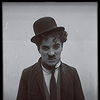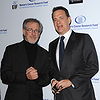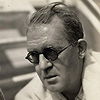Description:
George Stevens was a noted director whose films included "Shane," "Giant," and "A Place in the Sun."
Although he won Academy Awards for "A Place in the Sun" and "Giant," Stevens received world-wide acclaim for his postwar account of the harassment of Jews, "The Diary of Anne Frank," and for his 1965 account of the life of Christ "The Greatest Story Ever Told."
The son of actors, Stevens considered the acting competition too great when he moved to Hollywood in 1921. Instead, he became a commercial photographer and film cameraman.
He worked on the Hal R
George Stevens was a noted director whose films included "Shane," "Giant," and "A Place in the Sun."
Although he won Academy Awards for "A Place in the Sun" and "Giant," Stevens received world-wide acclaim for his postwar account of the harassment of Jews, "The Diary of Anne Frank," and for his 1965 account of the life of Christ "The Greatest Story Ever Told."
The son of actors, Stevens considered the acting competition too great when he moved to Hollywood in 1921. Instead, he became a commercial photographer and film cameraman.
He worked on the Hal Roach Studio's Laurel and Hardy films and in 1933 directed his first feature "The Cohen and Kellys in Trouble."
He subsequently directed for Columbia, RKO, Paramount, MGM, 20th century Fox and his independent Liberty Films Inc. which he formed with producer Samuel Briskin and directors William Wyler and Frank Capra.
During WWII, Stevens joined the U.S. Army Signal Corps as a major in charge of special photographic coverage of invasions tactics. Discharged as a Lt. Col., he served in six major campaigns in Africa, Europe and the Middle East. Stevens was with the American unit that liberated prisoners at Hitler's Jewish concentration camp at Dachau. He subsequently won the "survivor's award" from Histadreut, Israel's general federation of labor, for perpetuating the memory of Hitler's six million victims in his film "The Diary of Anne Frank."
The director later said it was at Dachau he decided to film the story of Christ which he did in 1965 as "The Greatest Story Ever Told."
Believing a great director could create the illusion of three dimensions in two and make his audience feel a part of the scene, Stevens scorned movie industry experiment with 3-D in the early 1950s.
He later lost a court battle which gave television the freedom to adapt movies to its own profitable use. the legal battle began in n1966, shown NBC telecast his 1952 film, "A Place in the Sun," interrupted by 33 commercials. The court did not prohibit the showing but said NBC could not tamper with the artistic value of the film.
Stevens maintained his original contract gave him exclusive control over the film's aesthetics which he said would be ruined by interjection of unrelated commercial subjects like body odor, ketchup and toothpaste. But the court refused to hold NBC in contempt saying the commercials did not "emasculate" the films artistry and that changes needed for adapting the film to the new medium could not be considered.
Ultimately Stevens won a token judgment of $1 in his $2 million civil suit, but television got the unquestioned right to commercialize movies.
... (more)
(less)
Tags: Director (3), Writer (2), Died 1975 (2), Born 1904 (2), Camera Operator (2), Producer (2), Male (2), American (2), Directors In The Military (1), Writers In The Military (1), Army Signal Corps (1), World War II Veteran (1), Born December 18 (1), Oscar Winning Director (1), Born In California (1), Directed A Best Picture Nominee (1), Died Aged 70 (1), Military (1), Sagittarius (1), Academy Award For Best Director (1)
My tags:
 Add tags
Add tags
 United States
United States 14 comments
14 comments 14 comments
14 comments 2 comments
2 comments 2 comments
2 comments










 TCM’s The Essential Directors (56 person items)
TCM’s The Essential Directors (56 person items) Directors' Favorite Actors/Actresses (94 person items)
Directors' Favorite Actors/Actresses (94 person items) Login
Login



























 Every Best Director Winner
Every Best Director Winner